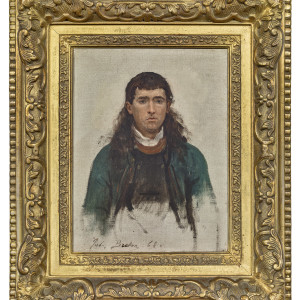Le Grand Pardon Breton ranks among Jules Breton’s most ambitious and multi-figured compositions.
Provenance
The artist's studio
His Sale: Galerie Georges Petit, Paris, June 2-3, 1911, lot 167, illustrated, as Le Chouan
Comtesse de Guigné (acquired at the above sale for 480 francs)
Sale: François Branger, Angers, December 14, 1991, lot 334, illustrated
Private collection
Catalogue note
Le Grand Pardon Breton ranks among Jules Breton’s most ambitious and multi-figured compositions. Exhibited to great acclaim at the Salon of 1869, the preparation for such a grand painting (it measures and impressive 130 by 182 cm., 51 by 71 ½ in) would involve many preliminary drawings and oil sketches for the figures who make up the final composition. Our painting is a preparatory study for the standing figure, who appears in the second row of the center group of the advancing procession.
Pardons were extravagant religious events that were prevalent in Brittany in the 19th century. They attracted many artists, including painters as diverse as Jules Breton and Pascal-Adolphe-Jean Dagnan-Bouveret to Paul Gauguin and Paul Sérusier, who were fascinated by the mysticism and spectacle of the gatherings. Breton wrote to his dealer, Samuel Avery that as many as ten or fifteen thousand peasants would unite for these penitential ceremonies (cited in Gabriel P. Weisberg, Jules Breton and the French Rural Tradition, Omaha, Joslyn Art Museum, exh. cat., 1982, p. 83). The pilgrims would dress in costumes from their specific parishes, and would carry banners, crosses and religious statuary identifying their patron Saints. The day would start with a Mass in early morning followed by a procession around the church.
Jules Breton was struck by the extreme religious fervor that characterized the Brittany Pardons, noting that they were nothing like he personally had experienced in his own Catholicism (see Weisberg, op cit). Was he hoping to convey the power of the gift of reconciliation in the faces of his penitents as an expression of their devout faith? The intangible becoming the tangible, and perhaps this is what he has so convincingly achieved in the face for our young pilgrim.






